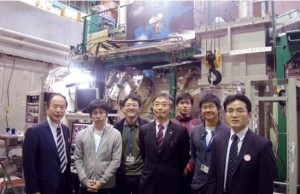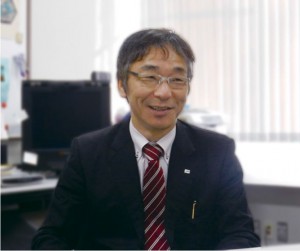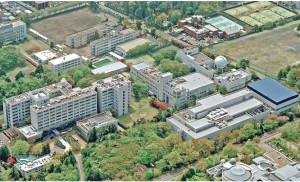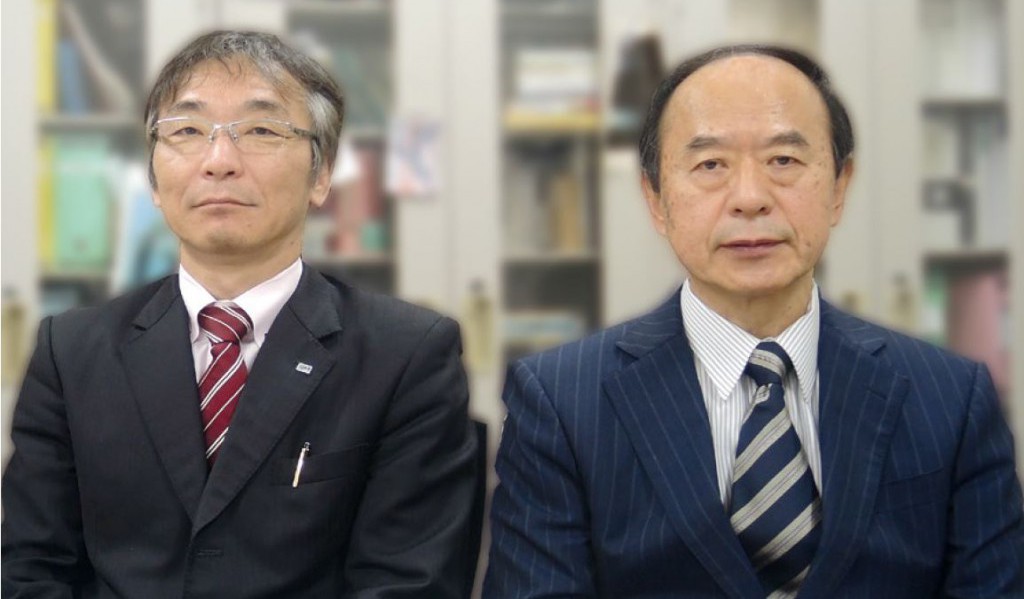This post is also available in: Japanese
Demonstrating to Young Children How Attractive Space Development is While Giving Them a Glimpse of the Future

Obinata: Recently, ULVAC established the new Future Technology Research Laboratory. Our aim is to consider what we will, or should be able to, achieve in 10 to 20 years’ time and to identify now what will sustain our future growth. I’m sure you’re developing various visions based on a close look at what things will be like in 10 or 20 years from now, but what inspires you to envision what will be needed in the future?
Kuninaka: It comes from considering what I will be doing in my job in the immediate future or in 3, 5, or 10 years from now. What inspires me is that this process may take 20 years or it may be realized very quickly. In addition to research and development, my job includes education in the form of instructing postgraduate students. I am constantly thinking about what research assignments I should give to new students, and I always come up with such assignments —including a more in-depth study of technologies that are close at hand— from flashes of inspiration and ideas that spring to mind.
Obinata: What kind of environment should persons in higher positions try to provide, or what should they do, to encourage engineers to have flashes of inspiration?
Kuninaka: They should give them opportunities to envisage what technologies should be available in the future. Everybody is probably very busy, so if you are told by your superior to do a particular job, you will think only about that job at all times because you are required to deliver results within one or two weeks. Of course, their immediate jobs need to be done, but what is important is to encourage your subordinates to think and envision what things will be like in 10 to 20 years’ time.
Space projects must be implemented over a long period of 10 to 20 years. I often have the opportunity to give lectures to children, who may go on to become researchers themselves in the future. On such occasions, I always use a chronological table as a visual aid to show what JAXA currently plans to achieve in its space development projects within the next 10, 20, or 30 years. Junior high school students and high school students will graduate from university and find a job 10 years from now, and 10 years after that, they will be working at the frontline of their organizations. At that time, the space development projects that I explain will be underway, so they should develop their talents in order to be able to contribute to such projects. If they are interested in space development, they should start to prepare themselves now. I always speak to children in this way in order to inspire them.
Obinata: I see. The idea is to encourage young engineers to come up with ideas on their own initiative by showing them what space development will be like 10 or 20 years from now.
Creating New Technologies Jointly with Private Enterprises with Outer Space as the Keyword
Saito: Having served as manager of the Hayabusa 2 project, what exactly are you doing now?
Kuninaka: We recently established a new department called the Space Exploration Innovation Hub Center, and I am working there with the support of the Japan Science and Technology Agency. I am chiefly in charge of joint technology research and development projects with private enterprises. Our primary objective is to promote technological developments that will contribute to the commercial activities of private enterprises. Since this is part of JAXA’s business, we do, of course, select technologies that can be used in space when we undertake joint development.
Saito: You must have trouble making arrangements for technology development.
Kuninaka: We have to find projects that will serve the purpose of the business. Fortunately, I believe that JAXA is delivering satisfactory results as a national research and development agency.
The government’s intention is that JAXA should share with private enterprises the schemes, expertise, knowledge, and equipment that it has developed through its space development projects.
A few decades ago, innovations often occurred, which resulted in things changing rapidly. Today, however, research and development has reached a saturation point worldwide in that we have an environment that prevents new innovations from being created easily. Old customs and inflexible ways of thinking do not lead to the creation of new innovations. Conversely, new ideas may emerge if we ask private enterprises to come up with something new using outer space as the keyword. If we think in this way, some unconventional ideas may emerge that can be used effectively in business. This is what is meant by JAXA’s call for the joint idea development that I described earlier.
Obinata: If we develop new ideas in earnest by linking our business with space projects, JAXA may be able to make use of them.
Kuninaka: I sincerely hope that you will propose something new to the Space Exploration Innovation Hub Center. If you propose something that is suitable for your business model and it meets JAXA’s vision for the future of space development, it will certainly be used.
Saito: Satellites float in the vacuum of space, but ULVAC provides a variety of technologies by creating vacuums on Earth. We do not have any specific ideas at the moment, but we would certainly like to submit some proposals to JAXA in the future.
Our Next Vision: Using Jupiter’s Gravity to Explore Planets Farther Away
Obinata: Finally, can you tell us about your vision for the future?
Kuninaka: Given that I am involved in space development, my next target is Jupiter. The gravity of Jupiter is strong because it is the largest planet in the solar system, which would allow us to use a maneuver known as a “gravity assist” or a “Jupiter swing-by.” The United States has sent Voyager and other explorers to Saturn and Pluto, but when they send probes beyond Jupiter, the probes always travel via Jupiter to make use of its gravity to achieve a stronger swing-by. If explorers are launched to go farther out into the solar system, they always need to go via Jupiter. Being able to reach Jupiter using Japanese technologies would provide us with opportunities to go beyond it. Developing routes to Jupiter independently will open up the way to going farther afield, in much the same way as European navigators discovering the Cape of Good Hope did during the Age of Discovery.
Obinata: If so, you will need ion engines with an even higher level of performance, won’t you?
Kuninaka: We will have to create more fuel-efficient ion engines. We have already started research and development into this. In addition to ion engines, we are steadily preparing new technologies that will allow us to reach Jupiter.
Obinata: How many years will it take before such technologies are available?
Kuninaka: That will depend on whether a budget is appropriated for this project, but we would like to realize them in the 2020s.
Obinata: It would be absolutely wonderful if the return of Hayabusa 2 and the launch of the next Jupiter mission would coincide with the Tokyo Olympics and Paralympics.
Kuninaka: I will have retired by then (laugh). I am currently interested in how I can interest young children in space projects. That is another job of mine. For space projects, successors cannot be produced unless their development starts during their childhood.
Obinata: That is truly a cosmic vision full of dreams, isn’t it? I sincerely hope that you will enjoy great success as you aim to reach Jupiter. Thank you for taking the time to talk to us today.
 Dr.Hitoshi Kuninaka
Dr.Hitoshi Kuninaka
Professor at the Department of Space Flight Systems,
Institute of Space and Astronomical Science
Director of the Space Exploration Innovation Hub Center, Japan Aerospace Exploration Agency (JAXA)
Born in 1960, Dr. Hitoshi Kuninaka graduated from Kyoto University in 1983 with a bachelor’s degree in engineering. In 1988, he obtained his ph.D of Engineering from the University of Tokyo, and then went
on to join the Institute of Space and Astronomical Science. In 2005, he became a professor at the Institute of Space and Astronomical Science. He also worked for the Department of Aeronautics and
Astronautics, Graduate School of Engineering, University of Tokyo. In 2011, he became director of the JAXA Space Exploration Center, and in 2012, he was appointed program manager of the Hayabusa
2 project. In 2015, he took office as director of the Space Exploration Innovation Hub, a post that he holds to this day.
[Awards received]
2004 Technology Award for the microwave-discharge ion engine, Japan Society for Aeronautical and Space Sciences
2006 Space Pioneer Award to the Hayabusa Project Team, National Space Society
2007 Technology Award for the Hayabusa asteroid exploration mission, Japan Society for Aeronautical and Space Sciences Best Paper Award for the paper on the ion engine, American Institute of Aeronautics and Astronautics
Best Paper Award for the paper on the ion engine, Electric Rocket Propulsion Society
2010 Electric Propulsion Outstanding Technical Achievement Award for the ion engine, American Institute of Aeronautics and Astronautics
58th Kikuchi-Kan Prize for the Hayabusa Project
Asahi Prize for the Hayabusa Project
Special Prize for the establishment of round-trip space technology in the Hayabusa asteroid mission, Minister of Education, Culture, Sports, Science and Technology
2011 Von Braun Award to the Hayabusa Project Team, National Space Society Laurels for Team Achievement for the Hayabusa Project Team, International Academy of Astronautics
2012 Fellowship of the American Institute of Aeronautics and Astronautics
International SpaceOps Award for Outstanding Achievement to Hayabusa Operations Team, SpaceOps Organization
2013 Stuhlinger Medal, Electric Rocket Propulsion Society

Overview (as of April 1, 2015)
Japan Aerospace Exploration Agency, a national research and development agency
Location: 44-1, Jindaiji Higashimachi 7-chome, Chofu-shi, Tokyo
Established: October 1, 2003
Budget: ¥154.1 billion
Number of employees: 1,527 (as of April 1, 2015)
President: Naoki Okumura
Predecessors:
Institute of Space and Astronautical Science (ISAS)
National Aerospace Laboratory of Japan (NAL)
National Space Development Agency of Japan (NASDA)
Major bases:
Chofu (head office), Sagamihara (campus), Tsukuba,
Tanegashima, and Kakuda (space centers), etc.
Profile:
The Japan Aerospace Exploration Agency (JAXA) is a national research and development agency that is responsible for Japan’s aerospace development policy. Supervised jointly by the Cabinet Office, the Ministry of Internal Affairs and Communications, the Ministry of Education, Culture, Sports, Science and Technology, and the Ministry of Economy, Trade and Industry, JAXA is the largest of all Japan’s national research and development agencies. It was formed in October 1, 2003 by combining the following organizations: t Institute of Space and Astronautical Science (ISAS); the National Aerospace Laboratory of Japan (NAL); and a the National Space Development Agency of Japan (NASDA). Its head office is located in Chofu City, Tokyo, where NAL was formerly situated.

